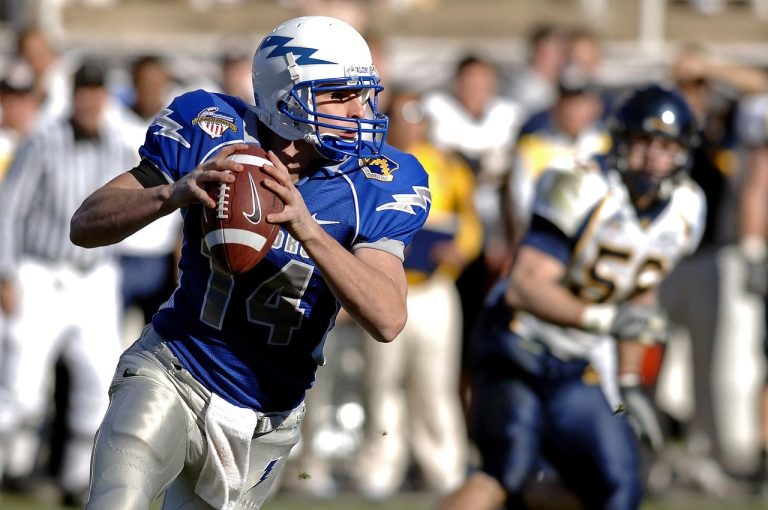Basic American Football Rules

American football is, unquestionably, the sport most loved by Americans and the least known outside the USA. If we exclude the Super Bowl, an event that goes beyond the simple game, few really follow the NFL consistently outside the United States.
- The basic rules of football
- Ball possession and 4 attempts
- The choices available to the quarterback
- The holding penalty
- Defense roles
Yet the National Football League has a sensationally hot fan base in America. Let’s get to know the rules of American Football better, starting with the line-ups on the field.
The basic rules of football
The game is played on a field that is 100 yards long (plus the two in-goals, each 10 yards long) and just over 53 yards wide. It is played eleven against eleven, but the roster is basically divided into three. The attack, which deals only with the offensive phase of the game, and the defense, with players who have to stop the opponents by preventing them from making a touchdown or scoring a field goal, even from far, far away…
And finally, the special teams, which almost always deal with fourth down, kickoff, or field goal situations.
Ball possession and 4 attempts
Every action is punctuated by “downs,” and the goal of every attack is to reach the closure of the “down.” To obtain the closing of the “down,” you must conquer ten yards, and to do so, you have four attempts available.
Let’s start with an example to try to be more clear. Assume a team begins its offensive action from 25 yards inside its own half-field; to close the “down,” it must reach or exceed 35 yards inside its own half-field. To do this, they will have four attempts available, but if they fail to reach them, they will lose the ball by handing it over to the opposing team.
For this reason, the attack almost always plays on three “downs,” then leaves the fourth attempt to the special team. The latter, through a kick made by the “punter,” will try to kick the ball as far as possible and return it to the opposing team away from his own end zone (half zone).
If the attacking team, after conquering ground, were to enter the last 10 yards of the opponent’s territory, there would no longer be talk of a first down and 10, but of a first down and goal, with the aim of entering the end zone to score a touchdown.
The choices available to the quarterback
In an attack, the management of offensive possession is entrusted to the quarterback, i.e., the player who will always control the ball and have the task of throwing it to his receivers. The QB will be protected by at least five offensive linemen, i.e., players who will only have the task of protecting him or helping the running back.
Each team has the obligation to field at least five linemen, who in passing situations will not be able to run forward for more than five yards; otherwise, a penalty will be triggered. One of these five linemen, or the center, will have the task of making the “snap,” or passing the ball under his legs to the quarterback to kick off the offensive action.
No attack player may move forward before the snap; if he does, he will incur a penalty (false start).
Of course, the offense is not forced to throw with the QB; it can also decide to rely on a running game involving, consequently, almost always the running back. This player usually plays next to or behind the quarterback. He is usually the smallest and fastest player on offense, and he also takes the most hits over the course of his career.
The holding penalty
Holding is one of the most common penalties for attacks, especially when it is done by linemen.
Any type of hold made outside your block automatically leads to a penalty, which costs the attack ten yards. Few are called to the San Diego Chargers, who are always among the betting favorites.
Defense roles
Defenders are divided into defensive linemen, linebackers, and defensive backs. The former deals with attacking the opposing offensive line in order to stop the runs and put pressure on the opposing quarterback. If they were to be able to stop the running back with a tackle, causing a loss of ground, a tackle for loss would be obtained, while if the quarterback were to be tackled, we would be faced with a “bag.”
Linemen must be careful not to tackle the quarterback after he throws to a receiver, in which case he incurs a 15-yard penalty, which can be very decisive even for live bets!
Linebackers can be classified as defensive playmakers; they have to call the defensive play and usually help the defensive linemen stop runs, while in a passing situation they defend against the running back and tight ends.
Defensive backs, on the other hand, mainly deal with the pass game, even if they are often decisive even on runs, avoiding large gains to the attack and perhaps in turn attacking the opposing defensive line. They are divided into cornerbacks and safeties.
The former has to defend against the opposing wide receivers, making their physicality felt and also trying to intercept the quarterback’s pass. What they cannot do is hold the receiver’s arm, in which case it would be pass interference, and the officials will be forced to consider the reception valid by restarting the offense from the position of the foul.
On the other hand, the safety’s job is to help the linebackers when they are being rushed, double down on the other team’s wide receivers during pitching plays, and provide deep coverage to stop touchdowns.





